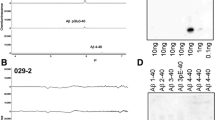Abstract
The brain of Alzheimer’s disease patients contains deposits of the 39–42-amino acid (∼ 4 kDa) amyloid β-peptide, which is derived from the β-amyloid precursor protein. These pathological deposits have been shown to consist in part of insoluble 8- and 16-kDa aggregates of the amyloid β-peptide. This report confirms that the amyloid β-peptide is a substrate for tissue transglutaminase (TGase) and demonstrates that human brain preparations from Alzheimer’s disease patients and control patients form cross-linked dimers from added iodinated amyloid β-peptide. Immunohistochemical staining for TGase revealed its presence in tissue sections and isolated amyloid plaque cores obtained from brains of patients diagnosed as having Alzheimer’s disease. These results provide evidence that the previously described insoluble amyloid deposits in Alzheimer’s disease may involve TGase-mediated cross-linked amyloid β-peptide polymers, and suggest a potential role for TGase in the pathogenesis of this disease.
Similar content being viewed by others
Author information
Authors and Affiliations
Additional information
Received: 23 September 1996 / Revised: 16 February 1998 / Accepted: 16 March 1998
Rights and permissions
About this article
Cite this article
Zhang, W., Johnson, B., Suri, D. et al. Immunohistochemical demonstration of tissue transglutaminase in amyloid plaques. Acta Neuropathol 96, 395–400 (1998). https://doi.org/10.1007/s004010050910
Issue Date:
DOI: https://doi.org/10.1007/s004010050910




